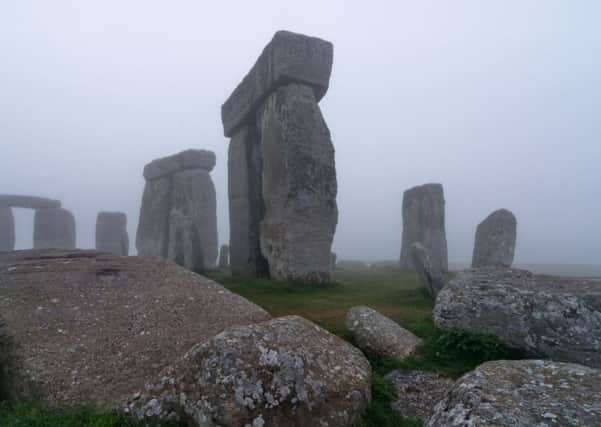Archaelogists unearth new monuments at Stonehenge


Archaeologists used ground-penetrating radar and 3D lasers scanners to create detailed digital maps of the ‘invisible’ landscape surrounding the famous neolithic site.
Results of the four-year study have revealed 17 previously undiscovered monuments and provided new information about known structures.
Advertisement
Hide AdAdvertisement
Hide AdTraces of as many as 60 giant stones or timber posts that could have stood up to 3m high were found at a previously identified ‘super henge’ at Durrington Walls, which lies to the east of the main edifice.
Surveys show the towering pillars, some of which may remain buried beneath the massive banks surrounding the construction, formed part of a 1.5km-wide ritual site that is believed to be the largest of its kind in the world.
Previously unseen types of monument were also identified, including massive prehistoric pits that may have been aligned to the stars.
As well the new finds, the work has provided unprecedented insight into hundreds of burial mounds and Bronze Age, Iron Age and Roman settlements.
Scientists say the findings have reshaped their understanding of how the ancient site evolved over more than 11,000 years.
“Stonehenge is the most iconic archaeological monument, possibly along with the pyramids, on the planet,” said project leader Professor Vincent Gaffney, from the University of Birmingham.
“However, the idea of what Stonehenge is for people is rather strange, especially if you walk around it. It sits there in splendid isolation.
“For the past four years we’ve been looking at this amazing monument to see what was around it, what was actually within its landscape.
“Most of the area around Stonehenge is terra incognita.
Advertisement
Hide AdAdvertisement
Hide Ad“It has never been explored and everything we think about Stonehenge is on the basis of what we don’t know about it.”
But he said the latest studies show an area of 12 square miles around Stonehenge is teeming with previously unseen archaeology.
“New monuments have been revealed, as well as new types of monument that have previously never been seen by archaeologists,” he said.
“All of this information has been placed within a single digital map, which will guide how Stonehenge and its landscape are studied in the future.
“This is going to change how we view Stonehenge.
“It is not yet another find from Stonehenge, it’s a fundamental step forward in the way we understand it.”
Among the many burial mounds is a 33m-long barrow containing signs that a massive timber building once stood within it.
Evidence suggests this was the site of complex rituals involving the dead, including the removal of flesh and limbs.
Prof Gaffney said the studies show Stonehenge was not an isolated structure on the edge of Salisbury Plain, but the centre of a complex and widespread arrangement of ritualistic monuments that had grown and expanded over time.
Advertisement
Hide AdAdvertisement
Hide Ad“The presence of monuments generates activity, which generates more monuments,” he said.
“What we’re seeing is this unconscious elaboration of the Stonehenge landscape.
“You’ve got Stonehenge, which is clearly a very large ritual structure which is attracting people from large parts of the country.
“But around it people are creating their own shrines and temples. We can see the whole landscape is being used in very complex ways.”
Stonehenge and its surroundings were laid out in a “highly theatrical arrangement”, according to the professor.
He said: “It’s truly impressive, and you get some feeling for how processional activities affected people.”
“Developing non-invasive methods to document our cultural heritage is one of the greatest challenges of our time and can only be accomplished by adapting the latest technology,” said Professor Wolfgang Neubauer, director of Vienna’s Ludwig Boltzmann Institute, a partner in the project.
“After centuries of research, the analysis of all mapped features makes it possible for the first time to reconstruct the development of Stonehenge and its landscape through time.”
Advertisement
Hide AdAdvertisement
Hide AdNational Trust archaeologist Dr Nick Snashall, added: ‘Using 21st-century techniques, the Stonehenge Hidden Landscapes team have transformed our knowledge of this ancient, precious and very special landscape.
“Their work has revealed a clutch of previously unsuspected sites and monuments, showing how much of the story of this world-famous archaeological treasure house remains to be told.”